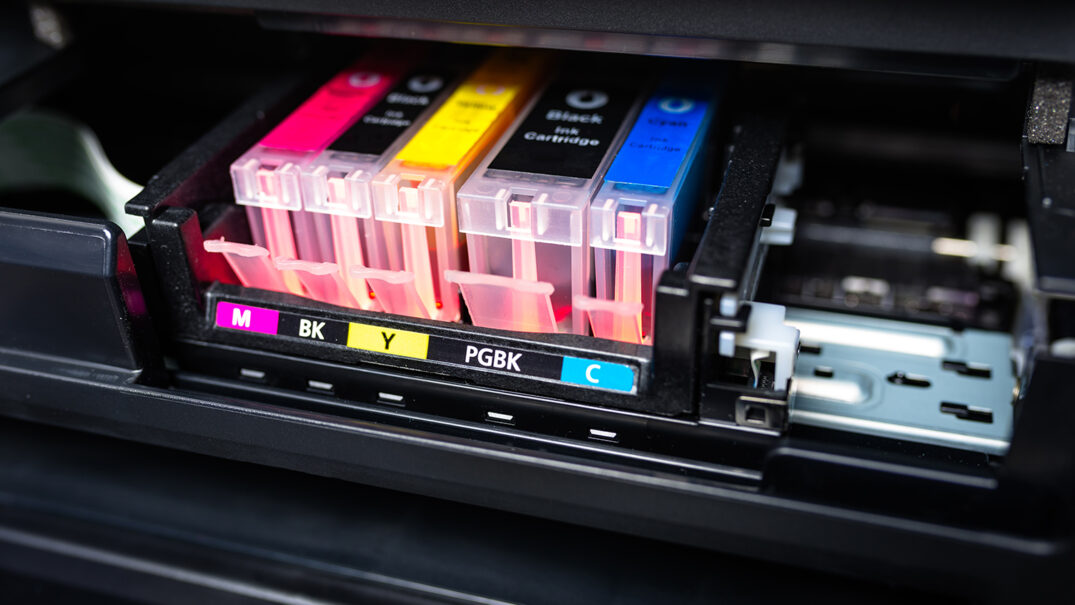Inkjet printer has thousands of microscopic nozzles: these nozzles spray the ink over the paper. Those ink droplets are tiny. So when it falls over the paper, it renders a high-quality image. This is possible for the cartridge. It consists of yellow, cyan, magenta, and black colors.
The colors mix up to create a better color combination: the concept is almost like a modern computer and tv screen. Tv screens render an image with the help of a thousand image pixel clusters. That’s the idea of the Inkjet printer.
Components of an Inkjet Printer
Maybe the process looks simple at first glance. To be honest, it is far more complicated than a laser printer. We are here to make the process comprehensive for you. As a part of that, here is the brief of inkjet printer components.

Print Head
Print heads are the core component of inkjet printers. Their job is to systematically spray ink on paper by creating images and texts. They determine the quality and resolution of printed pictures according to their number and size, a series of nozzles help print heads in this task.

Ink Cartridge
It is a component of an inkjet printer that stores the ink that is deposited on the paper. It is a replaceable component. Many people confuse ink cartridges with a print head. The difference is that ink cartridge is stored while the print head distributes ink.

Stepper Motor
The motor controls the printhead and ink cartridge. It balances the move to make a smooth print. This motor does not work the same for every device. Some are different; they have a unique motor to avoid accidental movement.

Belt
This belt attaches the print head and stepper motor. The belt controls the color spraying movement.
How Does an Inkjet Printer Work?
You have the idea of an inkjet printer. Now we will give you a short overview of its working process. It will help you to understand the rest of the topics.
- The printer processes an image or document from a device.
- Small nozzles (jets) are positioned throughout the printer to spray ink droplets onto a sheet of paper as it passes by. Hundreds of nozzles release thousands of ink droplets.
- To release an ink droplet, the nozzle is heated by electricity. The heat causes the ink to expand in a bubble, and it expands through the nozzle until it squirts onto the paper.
- When the ink bubble collapses, a vacuum is created that draws more ink into the nozzle from the ink cartridge, ready to release the next droplet.
- It takes many droplets to form a single character.
The nozzles are attached to a printhead, which can move left and right across the paper to create new characters.
Advantages of Inkjet Printers
There are many reasons a company might opt for an industrial inkjet printer. Here are some common benefits and advantages of choosing an inkjet:
Image Quality and Color
- The main reason for selecting an inkjet printer over other printers is the quality provided them. These are preferred for high-resolution printing which is as high as 1400 dots per inch. Dots per inch represents printed dots and the space between them and is the most familiar measure of resolution.
- The print quality text and graphics in both black and white and color included photos. The color of the image provided is vivid and bright. Exceptional tone and shade can be seen.
Low Cost
- As a buyer, your first preference must be price. And fortunately, you don’t have to compromise with money in the case of inkjet printers. They provide better quality with good value for money.
- The cost of inkjet printer cartridges is quite low. So if you want to refill it, you don’t have to give a second thought. These are preferred mostly in industries as they provide better quality printing at a relatively lower cost.
Easy to Use and Reasonably Fast
- They can be used even by students for various purposes like printing photos and making projects. These printers provide better color with the not-so-complicated operation.
- They are reasonably fast with the capacity of printing 20-30 papers per minute. It is because they take little to no warm-up time and start providing printed documents as soon as you operate them.
